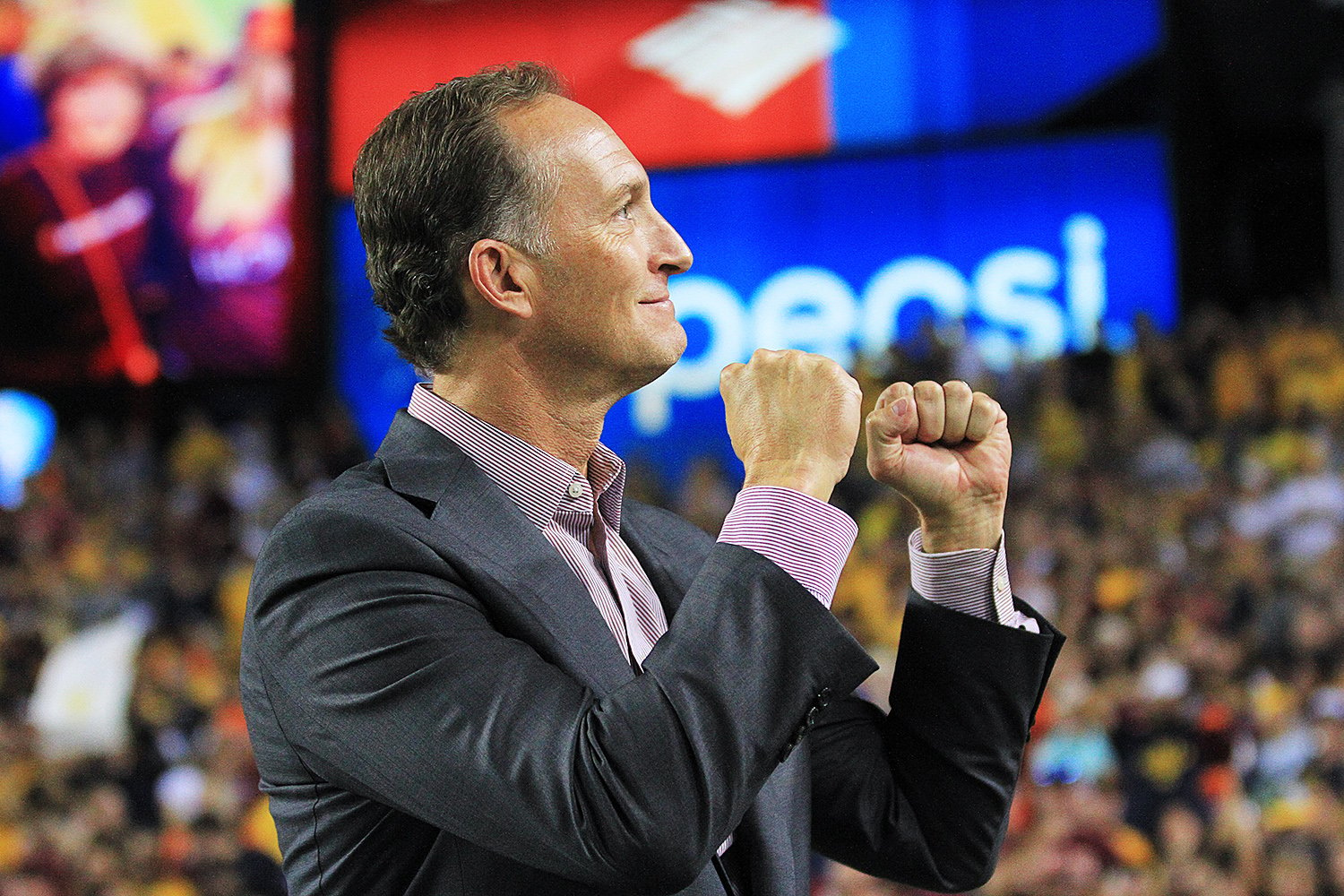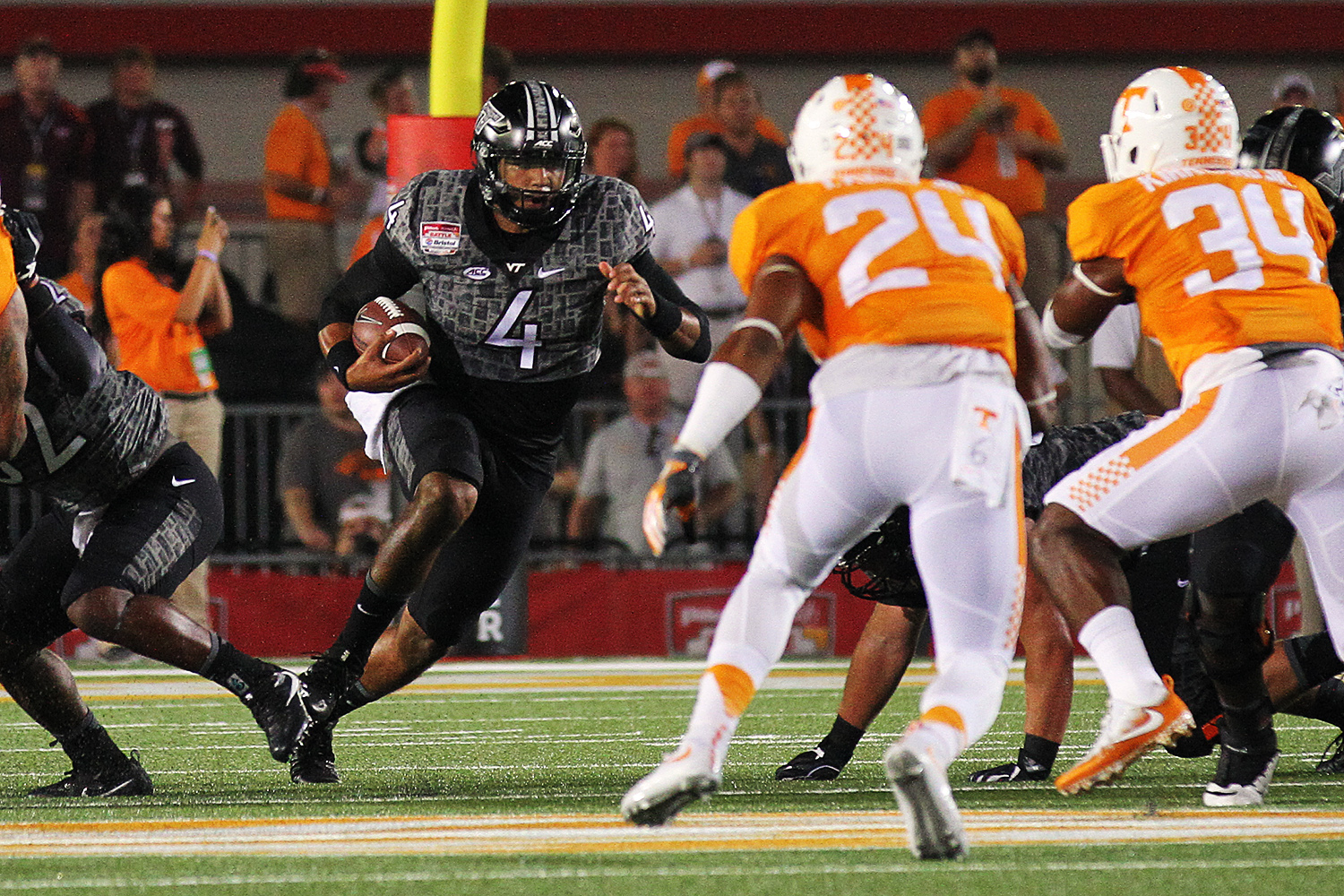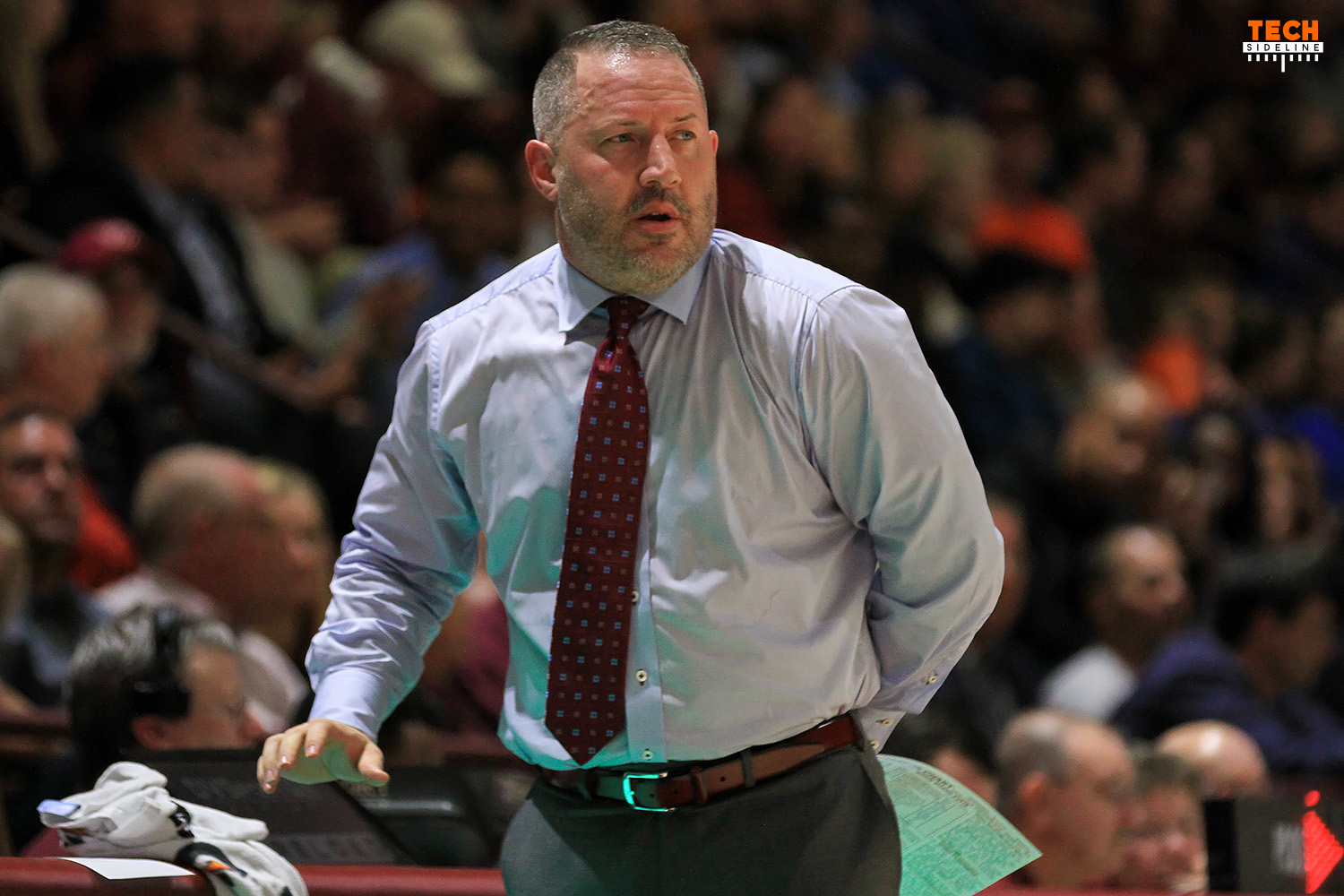
Recently, Virginia Tech director of athletics Whit Babcock sat down for a one-on-one interview with TechSideline.com. Babcock discussed a wide range of topics, from the recently canceled football series with Michigan and football scheduling in general, English Field at Union Park construction, future plans for Lane Stadium and Cassell Coliseum and men’s basketball head coach Buzz Williams.
This is part two of that interview. Both parts can be accessed here.
We’ll add notes of clarification in italics throughout the interview.
In a recent Virginia Tech Board of Visitors meeting, it was revealed that the Virginia Tech Athletic Department ran in the red for the second year in a row, after a couple decades of running in the black. The department was approximately $800,000 in the red in Fiscal Year 2016, and for FY 2017, that figure ballooned to $3.3 million in the red.
TechSideline.com: Running the department in the red — I think at this point, you’re investing in the programs, and that’s making you run a little in the red, but you’re counting on future revenue streams that haven’t arrived yet. I wanted to ask, number one, if that’s the philosophy, and number two, what is your relationship with the BOV that, when you report to them, “We’re three million dollars in the red this year,” they don’t freak out?
Whit Babcock: I need to at least start by giving a lot of credit to Jim [Weaver], the situation he left us in financially. I don’t think he was ever in the red.
TSL: We’ve been looking at finances since about 2000, and it was always in the black.
WB: Let’s talk about the last two fiscal years. I believe two years ago, we were about $700,000 in the red, and this year is going to be about $3 million.
We always want to balance and be responsible with resources, period, the end. Two years ago, that 700,000 in the red, was less than one percent of our budget. It was in that transition year of Coach Beamer retiring, of Justin [Fuente] being hired, of staffs crossing … we were spending a lot of money. To be less than one percent over, and to have gotten through all of that the way we did … we should always balance, but I don’t feel too badly about that.
This one this year, I’m really glad you asked that. Yes, there was a deficit of $3.2 million, but here’s how that happened. What we originally did, because we weren’t sure that all the Hokie Club fundraising was going to be as high as we needed it to be with the new stuff — we thought it would be, but we weren’t sure — so we had to take the [Battle at] Bristol $4 million guarantee money and move it over into the scholarship account to pay the scholarship bill. Then the Hokie Club and the Drive for 25 did better than we anticipated, and we have $7 million left in that bank account, so to speak …
TSL: Which is the scholarship “bank account.”
WB: Yes, that’s the way to put it, the way to think about it. So we have $3.2 million over here, and we have $7.2 million in this account. We never transferred the Bristol money back out; we can’t use scholarship money for operations. It would be like if you had two bank accounts, and you’re under $3.2 million in one, and up $7.2 million in the other, and yes, it’s a deficit, but it’s a pretty easy explanation.
An explanation of the moving of money that Whit Babcock is talking about can be found on page 404 of the materials for the open session of the Virginia Tech Board of Visitors meeting on March 25 and 26, 2018. The full materials can be downloaded in PDF form by clicking here, and the passage that specifically explains the FY 2017 athletics operating deficit, as a result of moving the Battle at Bristol money over into scholarship funds, can be viewed by clicking here.
In effect, Whit Babcock is saying that the $3.3 million operating shortfall was caused by transferring the $4 million Battle at Bristol payout over for use for athletic scholarships. The rest is accounting.

WB: This is also interesting: our expenses, if I’ve got this right, were ninth in the ACC, and our revenues were eighth. In the Power 65, our budget was 41st to 44th, and we were steadily going backwards. Now, this year, for this next fiscal year, I think we’ll be approaching $94 or $95 million, and soon we’ll be approaching $100 million a year athletic department.
We have also worked with the finance folks on campus and have shared with the board a ten-year forecast of a few lean years or tight years. Then, whether it’s the ACC Network or some of the other things we have, we’ll be coming out of it.
I want our folks to know, we don’t take lightly how it happened. We can explain the big number this year. It’ll probably be similarly tight, down to the wire next year, but we feel like we’re competing and doing well, and that we’re doing all right.
The money we are spending right now is in the bottom half of the ACC, and in the bottom half of the Power 65, but our fans and us and Virginia Tech don’t want us to finish in the bottom half. So we’re being as responsible as we can be, but we have a plan, and no, I do not enjoy finishing in the red.
But when they saw that big number, the people that pulled that from the BOV report the other day – that board report is huge – they missed a couple pages back where we explain that point.
The report (open session materials), linked above, is indeed huge. It’s 616 pages. The passage that explains the deficit is also linked above, and as noted, it comes from page 404.
TSL: The increase in the cost of the ACC Network studio facilities — you anticipated in the $5-$7 million range, and it wound up being $10 million. What caused that? And in a related question, in a recent press release, you thanked Tim Sands and the BOV, and you specifically mentioned a “partnership.” Can you expand on that?
WB: When we were first being told about the network, that was the estimate I recall us receiving. No one said that was final or concrete, but I remember it being in the $4-$6 million range. Then some of the people I know in the SEC chuckled and said, “That’s what we thought, too”, and it ended up costing most of them, depending on what they spent, $8-$15 million.
TSL: So let’s stop right there and address that, because this is a bone of contention on message boards. So the SEC people did fund their own network studio operations?
WB: Yeah, absolutely.
TSL: Because people are angry, saying things like, “ESPN paid for the SEC, and now they’re making the ACC pay for their own.”
WB: No, no. That’s not the case.
Ours, the way it’s written is, it gives us the ability to spend up to $10 million. The board gives you a limit you can’t go over. So I’m still hopeful we don’t hit $10 million.
But essentially, the construction in the South end zone, and Tom Gabbard’s doing a great job with that, that’s a pretty good space, it has good bones, and you can do a lot of stuff in there. The construction is probably only a million and a half, maybe two million. All the equipment, computers, studio stuff, is $7 million. Just the equipment.
TSL: The worst part is that the stuff becomes obsolete rather quickly.
WB: It could. But here’s how it works. You spend the money on the studio, and you can get a loan on that. The first revenue from the network will go for all the startup costs. Once we start clearing money, hopefully that network will be so good it won’t take long to get back the $10 million.
So nobody did anything wrong, it’s just like a lot of things, when you get a quote on your home improvement, what does it wind up being when it’s all said and done? (laughs)
TSL: So what role does the university play in this?
WB: Right, that’s the partnership referred to. With the students we hire in HokieVision right now, it’s about 20-40. That will go probably well over one hundred now with the network. To be able to have a Communications degree and program and some campus opportunities for those students to learn in a real, legit, linear, ESPN-quality production, that’s the partnership.
So it’s our expenses in the athletic department, and our revenue, but the things we can do for students and let the campus use some of that space, too, that’s what I meant by partnership.
The studio, or the set aspect of it, I believe we’re going to put it right inside the front door of Lane Stadium, right off of Beamer Way, so when you look through the glass, set back in there, it might say the Virginia Tech or the ACC Network studio. It’ll look good. Some of the display and the memorabilia that’s currently there, we’re not going to get rid of it. It might go up to the second floor. But that’s a space that we don’t use near enough right now.
From a recruiting standpoint, when you come up the road and you see it, it’s a beautiful space. We’ll move some of it in there. Most of the operations will be in the South end zone, but we’ll have a set there [in the West side]. We have the Hokie Club in there now, and we have the student academic support there now, and we’ll move our student athlete development there, as well.
TSL: How many studios do you envision there being?
WB: In the South end zone, you’ll have two control rooms, so you could do two events simultaneously. So let’s say you could have baseball, softball, both going on at the same time. You could run that out of the South end zone, and then you’d have two or three [studio] spaces in that area we’re talking about in the West side. The other piece of that is all the fiber that’s now going to baseball, softball, the competition facilities. That’s stuff that no one will ever see.
Everything Whit Babcock is describing was included in Virginia Tech’s press release on Virginia Tech’s ACC Network operations, which can be seen by clicking here.

TSL: There are annual rumors, it seems, about Buzz Williams moving on from Virginia Tech. Every time the Oklahoma State job opens, or the Texas job opens, or a job like that, in that area where Buzz is from. How do you deal with that as an athletic director?
WB: I’ve not heard any of that from Buzz at all, and I don’t mean to be naïve, but I just believe we have the relationship that he would let me know if that’s a serious thing. We don’t take him for granted, nor Justin [Fuente], but I really believe both of them are very happy and like what we’re doing here. They have a chance to make their mark and those types of things.
Do I worry about it? Sure, but I feel like he’s really happy here, and to my knowledge, he’s not out seeking it or looking, and I know he’s had a number of opportunities come his way, just like Justin, that they chose not to look at. So I appreciate those guys.
And I’d like to think – actually, I know he would – Buzz would let me know.
TSL: By the same token, as an athletic director, do you always have a list?
WB: That’s a little overexaggerated, I think.
TSL: That’s how people talk about it. “Oh, Whit’s got a list.”
WB: I think in some ways, if your list is too developed, you’re kind of selling out the current coach that you have. Yeah, you pay attention to what’s going on, but if you search my desk drawers right now, there’s no written list.
But you pay attention to what’s going on. Hopefully, we don’t have to be in that line of work. Again, I don’t want to be naïve about it, but we don’t feel like Virginia Tech takes a back seat to anywhere. It’s a destination job, and they get paid very well. Go back to those eight-nine numbers in the ACC.
TSL: Buzz is one of the top 15 or so paid guys in the country.
WB: I think he’s 19th out of all the public schools. Keep in mind, our budget’s 41st. Buzz and Justin both are right around 25th in the country, give or take, once you include the private schools. That’s the thing, four million last year was 20th before the season started, and now Justin will make four million next year. So I’m estimating he might be 25th or 26th, and Buzz, if you take the private schools into consideration, he’s probably in that same range.
Did we set out to do that? No, we just pay as much as we can afford to get guys who can do a good job. You have to make the decision, do you want to be at Virginia Tech for the long haul, and I believe they both really like it here.
TSL: Your spending, putting relatively more into salaries, fits with your philosophy of out-peopling other schools.
WB: There has to be more than a paycheck. You want to be competitive, certainly. The numbers that are being thrown around are really something.
TSL: At this point, we have not received the final Hokie Club membership numbers for the end of March, which is a critical time. They haven’t been released publicly yet. The number as of a week ago was 12,700 people. Last year, I think it was 13,600.
WB: When the dust settled [from season ticket renewals and contribution deadlines].
TSL: Where would you like to see that number this year? What’s the annual goal as you push towards 25,000?
WB: Higher than the year before (chuckles). Ideally, we focus on keeping the donors that we do have, because if you never lose one, then your number never drops. Our late March numbers probably won’t be final till about mid-April, as everything runs through the system. We don’t want anyone to miss any deadlines, so we call like crazy and chase some late renewals to make sure people don’t lose priority on their seating location.
Our dollar numbers we’re tracking, like last year on the Hokie Scholarship Fund, which is great, because last year was a reseating year. You get spikes during reseating years, but this went up last year, and I think it’s going to stay right there. Our overall fundraising numbers will be way higher because of the $15 million gift for the performance center, but I don’t know that we will have tremendously more donors this year than last year, and I don’t love that fact, but I’d rather appreciate the donors we have than call out the ones we don’t.
But we still do legitimately believe we can get to that 25,000, so we’ll see. Raising more money is always good, but I like the participation numbers too, and surely, we’ve got room for more.
After this interview was conducted, Virginia Tech revealed a total fundraising record of $47.7 million for the one-year giving cycle that ended on March 31, 2018, shattering the old record of $33 million set the previous year. $16.8 million of that was for scholarships, breaking the one-year-old record of $16.2 million. Unfortunately, the number of donors making those contributions fell from 13,170 on April 5, 2017 to 12,830 on April 4, 2018, per the Drive for 25 tracking site.
TSL: How did football season ticket renewals go, and do you ever see Virginia Tech doing what UNC did and reducing capacity in the football stadium in favor of a more premium seating experience?
WB: I have not seen our final numbers this year [for season ticket sales]. When I have seen them, they’re either so close or above last year or just below, that the discrepancy doesn’t jump out at me vs. last year.
This year’s schedule has seven home games and $400 season tickets. Season tickets were $350 for the last few years before this one. This year we have a seventh home game, and Notre Dame, as well as Miami and UVA. So we certainly thought we could charge more than $400, and people would probably pay it, I guess. But we’ve decided to go a little bit lower this year [on a per-game basis], because our 2019 home schedule isn’t as attractive, and it only has six games.
What you don’t want to do is go up on season tickets this year and then back down next year, so we’re trying not too increase it too much this year, even with the seventh game, in the hopes that we can carry this year’s price over to next year. But a lot of that will have to do with how our fans feel in the moment and about our season. That’s some of the thought process there, to not get too greedy on it this year.
Regarding the seating, we have started to talk or consider maybe one day putting some chairback seats on the east side, maybe one or two thousand seats with an indoor club tucked underneath. We’ve talked about potentially doing some work on those indoor club areas that we already have on the West side, maybe opening up those windows, but that’s a big expense.
There is nothing at all firmly planned, but we won’t go overboard on the premium seating, but the days of just offering metal bleacher seats … I don’t see too many schools adding bleacher seats, do you?
TSL: No. So is it correct to say that if you ever do see the bleachers pulled out and replaced with chairback seats, that it would also be done in concert with some other things?
WB: Yes, and right now, we feel like, in our next upcoming capital campaign, which is probably two years away, that our top priorities at that time will be Cassell Coliseum, Lane Stadium, and scholarships. Now if you walk in here and say, “I like soccer,” we’ll have something for you. But that’s why we’re hustling and bustling on all these other projects, and we’re also working on the football weight room. To try to get all that done – baseball, Rector, the performance center, the weight room – and then come into that capital campaign, I think those will be three pretty simple, outstanding choices for people to give to: scholarships, Lane, or Cassell.
TSL: That’s all. Thanks for your time, Whit.
WB: Sure. Go Hokies.





 Print
Print







Great interview, but the 2019 home football schedule leaves a great deal to be desired (our out of conference home games are Furman and ODU) and he is crazy if he thinks he can charge next year what he did this year for season tickets. Good luck.
A very interesting set of interviews. Thank you Will! And thanks too to Whit.
We are definitely in good hands with Whit!
Best thing is to hear about the coaches, and that they are being paid well enough to keep them home….except for the exorbitant $$$ paid by the blue-bloods. Most importantly that they are happy being here….VT and Blacksburg are special places!
I feel better about Whit and the budget. Thanks for a great article Will.
Great job Will. Enough can’t be said.
Great interview I found out more about VT Sports in these two articles than the questions I had thanks Will
Good stuff, thanks and very glad VT is giving TSL solid access. You guys do a great job and VT is wise to work with you this way.
No question about Metallica? TIC
Whit is a classy guy giving straight complete responses which is awesome… and your questions were also well thought out, Will, and brought great additional perspective to areas we did not have detail on!
I really enjoyed these articles. Thank you.
Tom Gabbard is definitely “the man”. Amazing what he has built/rebuilt in the area from Lane (including the indoor practice facility) and Cassell to English Field, plus the swimming and diving facility in Christiansburg!
Amazing!
Strong, insightful interview, Will! Great stuff and thanks!
Awesome & thanks for the clarity on the SEC payment of their own studios. That was fresh news!
Let’s Go…Hokie!!!
BEAT FSU!!!
As I have said many times since his hire “Whit is the man.” Great interview Will. Go Hokies!!!!
The most interesting and informative article/interview I’ve read on TSL in a very long time. Thanks Will.
Great 2-part interview, thanks. Soccer? Are there plans for a new video board for Thompson Field?? As far as seating goes, if they wanted to expand, all they can really do is add to the 2 lower sets of stands. Maybe some rooftop seating on top of McComas………….
Damn, I love that guy. And you too, Will…
Definitely a good “to the point” interview and responses by Whit.
Really well done Will. Congrats!